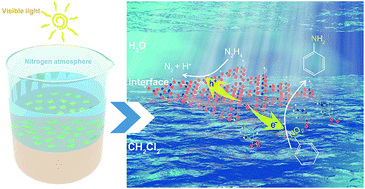Amphiphilic two-dimensional graphitic carbon nitride nanosheets for visible-light-driven phase-boundary photocatalysis†
Abstract
Phase-boundary catalysis on the liquid–liquid biphasic interface has great potential in various applications due to the advantages of the energy-saving, possibly organic solvent-free process and post-synthesis treatment of products and catalysts. Notwithstanding significant development in visible-light-driven photocatalysis for energy and the environment, the application of graphitic carbon nitride (g-C3N4) in organic synthesis is limited because of its poor dispersibility in organic solvents. Herein, we report amphiphilic two-dimensional g-C3N4 nanosheets (CNNS) with two hydrophilic/hydrophobic functionalities synthesized by soft-chemical exfoliation and covalent modification with the 4-(trifluoromethyl)benzyl (TFMB) group. As a phase-boundary photocatalyst, these amphiphilic CNNS on the oil–water biphasic interface can drive the photocatalytic reduction of nitrobenzene to aniline without any external stirring. Impressively, easy extraction of the synthesized aniline by the water phase favors product separation. Such an amphiphilic CNNS photocatalyst also shows good performance for different organic solvents or even solvent-free systems, multiple reuses, and nitrobenzene compounds substituted with various groups, indicating an innovative application for organic synthesis.

- This article is part of the themed collection: 2019 Journal of Materials Chemistry A Most Popular Articles


 Please wait while we load your content...
Please wait while we load your content...